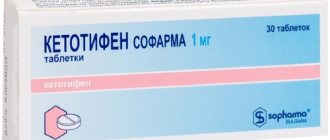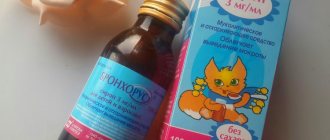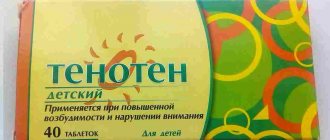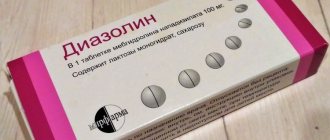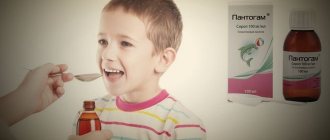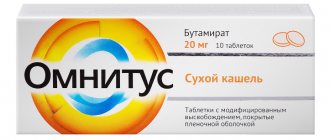Many parents know about childhood allergies from their own experience. Hay fever, allergic dermatitis or bronchitis can affect children of all ages. And as with many other diseases, it is always easier to be proactive.
If your baby has already had immune problems, the doctor may prescribe Ketotifen as a preventive measure. What kind of medicine is this and how it works, let's talk further.
Release form
Manufacturers produce four dosage forms of the drug:
- tablets – 1 mg of active ingredient;
- capsules with the same content of active ingredient;
- syrup, each milliliter of which contains 2 mg of ketotifen.
The three forms listed are for oral administration. But to treat conjunctivitis, drops are used to instill the conjunctival sac.
Compound
The active substance is the same everywhere - ketotifen fumarate, and the auxiliary ingredients in different dosage forms differ:
- one tablet, in addition to 1 mg of the active ingredient, contains microcrystalline cellulose, magnesium stearate, talc, silicon dioxide;
- One capsule contains 1 mg of ketotifen plus calcium stearate, lactose monohydrate and microcrystalline cellulose. The composition also includes: gelatin, methylparaben and sodium propylparaben, titanium dioxide and dyes E 131, E 151;
- every 5 ml of syrup contains 1 mg of ketotifen hydrofumarate and other ingredients: sodium benzoate, liquid maltitol, sodium saccharin, citric acid, glycerin, hydroxyethylcellulose, banana flavor, purified water;
- in eye drops, the dosage of the active substance is 0.25 mg per 1 ml of solution. Auxiliary ingredients: sodium chloride and benzalkonium, dextran, Trilon B, sodium hydroxide, citric acid, purified water.
Analogues, price, storage conditions, reviews
A number of analogues are known. These are Pozitan, Zaditen, Claritin, Ketone, Lecrolin, etc. Their active components act in a similar way, only the name differs.
However, the advantage of Ketotifen is its relatively low price. For example, a bottle of 10 ml drops will cost approximately 100-140 rubles, tablets No. 30 - 70-100 rubles. Syrup 100 ml costs 90-120 rubles. Prices vary depending on the region and the pricing policy of a particular pharmacy.
All forms of medication are dispensed in the pharmacy chain only by prescription. The shelf life is 3 years. The product must be stored at a temperature not exceeding 25 degrees.
Both specialists and patients respond positively to Ketotifen. It is noted for its effectiveness, ease of use, and affordable price. However, not everyone is happy that the product does not provide an immediate effect. Many people experience drowsiness as a side effect, which is inconvenient if a person is constantly driving.
In general, Ketotifen is a proven and effective remedy that relieves the main allergic symptoms and improves the well-being of patients. The only important thing is strict adherence to the recommendations of the attending physician.
Indications: why is it prescribed for children?
The medicine is prescribed to children for prophylactic purposes to prevent or reduce the manifestations of such diseases:
- bronchial asthma;
- allergic bronchitis;
- hay fever;
- allergic inflammation of the nasal mucosa;
- dermatitis, urticaria;
- conjunctivitis.
According to the instructions, the drug is also indicated for the symptomatic treatment of allergic rhinitis and conjunctivitis in children. But Ketotifen is not used to relieve an attack of bronchial asthma.
No Allergies!
Ketotifen is an antiallergic drug that has a pronounced antihistamine effect. The medicine is produced by pharmaceutical companies in Russia, Poland, Bulgaria, and Indonesia.
The Ketotifen line includes capsules, tablets, syrup, and eye drops.
How does Ketotifen work?
Having a stabilizing effect on mast cell membranes, Ketotifen has a moderate H1-histamine-blocking effect, prevents the release of histamine and leukotrienes, reduces the concentration of eosinophils in the tracheobronchial tree, and stops early and late asthmatic reactions to allergens. While preventing the development of bronchospasm, Ketotifen does not have a bronchodilator effect.
After taking Ketotifen orally, the therapeutic effect develops after 40-60 minutes. The half-life is approximately 10 hours. The maximum therapeutic effect on the body is observed after 2 months. after starting therapy.
For what diseases is Ketotifen prescribed?
Indications for prescribing the medicine are the prevention and treatment of allergies:
- Hay fever;
- Atopic bronchial asthma;
- Allergic rhinitis;
- Urticaria;
- Allergic conjunctivitis;
- Allergic bronchitis;
- Allergic dermatitis.
Contraindications for use and side effects
Taking Ketotifen is contraindicated in the following conditions:
- Intolerance to the components of the drug;
- Pregnancy, lactation period;
- Ketotifen should be prescribed with caution to patients with epilepsy, liver and kidney failure.
Side effects may include drowsiness, dizziness, anxiety, sleep disturbance, nausea, vomiting, dysuria, and allergic reactions.
In case of an overdose of Ketotifen, drowsiness, shortness of breath, decreased blood pressure, convulsions are observed, and coma may develop. Prescribe symptomatic treatment, gastric lavage, and intake of enterosorbents: Polysorb, Activated carbon, Lactofiltrum, Enterosgel. For convulsive syndrome, barbiturates and benzodiazepines (Relanium, phenazepam) are used.
Directions for use, dosage
It is recommended to take Ketotifen orally with meals. For adults, 1 milligram is prescribed twice a day. If indicated, the dosage can be increased to 2 milligrams per day. For children up to 6 months. Give syrup at a dosage of 0.05 milligrams per kilogram of weight. Children from 6 months. up to 3 years old, give 0.5 milligrams twice a day; children over 3 years old – 1 milligram twice a day. The duration of therapy with Ketotifen is at least 3 months. Therapy is discontinued gradually over 2 to 4 weeks.
Is it possible to prescribe Ketotifen during pregnancy and lactation?
The medicine is not prescribed to pregnant women or breastfeeding women, as the components of the medicine can have a negative effect on the fetus and newborn. To select safer medications, consult your doctor.
Are there any analogues of the medicine?
Direct analogues of Ketotifen can be considered Zaditen (France), Histafen (Latvia). These drugs have similar pharmacological effects. The price of Zaditen and Gistafen is significantly higher than the cost of Ketotifen.
Antihistamines have a similar antiallergic effect: Loratadine, Claritin, Cetrin, Zyrtec, Erius, but Ketotifen is more effective in the treatment of bronchial asthma. The price of these drugs is slightly higher than the cost of Ketotifen.
Storage conditions of the drug
It is recommended to store Ketotifen away from sunlight, at ambient temperatures up to 25 degrees Celsius. Shelf life is three years.
Price of medicine in a pharmacy chain
The cost of Ketotifen may vary slightly depending on the manufacturer. Average price of the drug in pharmacies:
- Tablets (1 mg), in a bottle, 30 pcs. – 30 – 40 rubles.
- Syrup (2 mg/ml), in a bottle (130 ml) – 30 – 40 rubles.
- Eye drops (10 ml) – 160 – 170 rubles.
Home — Medicines
In this article you can read the instructions for use of the drug Ketotifen . Reviews of site visitors - consumers of this medicine, as well as the opinions of specialist doctors on the use of Ketotifen in their practice are presented. We kindly ask you to actively add your reviews about the drug: whether the medicine helped or did not help get rid of the disease, what complications and side effects were observed, perhaps not stated by the manufacturer in the annotation. Analogues of Ketotifen in the presence of existing structural analogues. Use for the treatment of urticaria, hay fever and other allergic diseases in adults, children, as well as during pregnancy and breastfeeding. Composition and interaction of the drug with alcohol.
Ketotifen belongs to the group of cycloheptathiophenones and has a pronounced antihistamine effect. Does not apply to bronchodilating anti-asthmatic drugs. The mechanism of action is associated with inhibition of the release of histamine and other mediators from mast cells, blocking histamine H1 receptors and inhibition of the phosphodiesterase enzyme, resulting in an increase in the level of cAMP (cyclic adenosine monophosphate) in mast cells.
Suppresses the effects of PAF (platelet-activating factor). When used independently, it does not stop asthmatic attacks, but prevents their occurrence and leads to a decrease in their duration and intensity, and in some cases they completely disappear. Has a beneficial effect on sputum production.
Compound
Ketotifen fumarate + excipients.
Pharmacokinetics
Absorption is almost complete, bioavailability is about 50% (due to the presence of the “first pass” effect through the liver). Passes through the blood-brain barrier. Passes into breast milk. Metabolized in the liver. It is excreted by the kidneys in the form of metabolites (the main metabolite, ketotifen N-glucuronide, is pharmacologically inactive). Within 48 hours, the bulk of the dose taken is excreted by the kidneys (1% unchanged and 60-70% in the form of metabolites).
Indications
- atopic bronchial asthma;
- hay fever (hay fever);
- allergic rhinitis;
- allergic conjunctivitis;
- atopic dermatitis;
- hives.
Release forms
Tablets 1 mg.
Syrup (sometimes mistakenly called drops).
Instructions for use and dosage regimen
Orally, during meals, adults - 1 mg 2 times a day in the morning and evening. If necessary, the dose is increased to 2 mg 2 times a day.
Children aged 3 years and older - 1 mg 2 times a day.
The duration of treatment is at least 3 months. Cancellation of therapy is carried out gradually, over 2-4 weeks.
Side effect
- drowsiness;
- dizziness;
- slower reaction rate (disappears after a few days of therapy);
- sedative effect;
- feeling tired;
- anxiety;
- sleep disorders;
- nervousness (especially in children);
- dry mouth;
- increased appetite;
- nausea, vomiting;
- constipation;
- dysuria;
- thrombocytopenia;
- weight gain;
- allergic skin reactions.
Contraindications
- pregnancy;
- lactation period;
- children under 3 years of age;
- hypersensitivity.
special instructions
Abrupt cancellation of previous treatment with beta-adrenergic stimulants, glucocorticosteroids, adrenocorticotropic hormone (ACTH) in patients with bronchial asthma and bronchospastic syndrome after joining ketotifen therapy is undesirable; cancellation is carried out for at least 2 weeks, gradually reducing the dose. Treatment is stopped gradually, over 2-4 weeks (relapse of asthmatic symptoms is possible).
For persons sensitive to sedative effects, the drug is prescribed in small doses in the first 2 weeks.
Not intended to relieve an attack of bronchial asthma.
In patients concomitantly receiving oral hypoglycemic agents, the platelet count in the peripheral blood should be monitored.
Impact on the ability to drive vehicles and operate machinery
During the treatment period, it is necessary to refrain from driving vehicles and engaging in potentially hazardous activities that require increased concentration and speed of psychomotor reactions.
Drug interactions
Enhances the effect of sleeping pills, antihistamines, ethanol (alcohol).
In combination with hypoglycemic drugs, the likelihood of developing thrombocytopenia increases.
Analogues of the drug Ketotifen
Structural analogues of the active substance:
- Zaditen;
- Zaditen SRO;
- Ketotifen Sopharma;
- Ketotifen Stada;
- Ketof;
- Positan;
- Staffen;
- Frenasma.
If there are no analogues of the drug for the active substance, you can follow the links below to the diseases for which the corresponding drug helps and look at the available analogues for the therapeutic effect.
The antihistamine drug Ketotifen is an effective remedy for the complex treatment of atopic bronchial asthma. The medicine alleviates the condition of patients with other types of chronic diseases of an allergic nature.
Therapy using Ketotifen tablets, syrup and eye drops will be successful if several conditions are met. It is important to learn the nuances of using the drug, read the instructions, and consult an allergist.
- Composition and release form
- Action
- Ketotifen: indications for use
- Contraindications
- Instructions for use and dosage
- Possible side effects
- Overdose
- special instructions
- Price
- Analogs
- Reviews
An effective medicine contains the active substance – ketotifen fumarate. The drug complements the action of antiallergic drugs of the latest generations, and in combination exhibits a noticeable antihistamine effect.
To eliminate signs of allergies and prevent attacks in patients with bronchial asthma, the manufacturer offers several types of the drug:
- pills. The content of ketotifen in each unit of the drug is 1 mg;
- eye drops. The concentration of ketotifen fumarate is 0.25 mg in each milliliter of medicinal solution;
- antiallergic syrup Ketotifen. There is 1 mg of active ingredient per 5 ml of the drug.
An effective antiallergic medicine belongs to the group of non-bronchodilating anti-asthmatic drugs. The peculiarity of the manifestation of the therapeutic effect is as part of complex treatment. The use of Ketotifen as the main drug does not stop asthmatic attacks.
Learn about the symptoms and treatment of hives in adults with medications.
The most effective allergy remedies for children and adults are collected in this article.
How the active ingredient works:
- inhibits the release of histamine and inflammatory mediators;
- blocks H1-histamine receptors;
- suppresses the effects of a special platelet-activating factor;
- when combined with other antihistamines, the duration is reduced, the strength of allergic attacks is reduced, and the frequency of acute reactions is reduced;
- Some patients note that after therapy with Ketotifen, severe manifestations of bronchial asthma ceased to bother them.
On a note! The antiallergic drug is not suitable for quickly relieving signs of dangerous allergic reactions: anaphylaxis, generalized urticaria. The positive effect is noticeable after 3–4 weeks, in some cases, later from the start of complex treatment. The optimal course duration is two to three months. To eliminate acute signs of allergies, fast-acting 1st generation drugs are needed.
Ketotifen: indications for use
The main purpose of the drug is to use it as an auxiliary drug for long-term therapy of bronchial asthma (atopic variety). A positive effect was noted in the treatment of rhinitis and allergic conjunctivitis.
Patients should know: uncontrolled use of the drug to relieve attacks of bronchial asthma or manifestations of other diseases that develop against the background of increased sensitivity of the body is prohibited. The drug based on ketotifen fumarate acts quite “mildly”, but has limitations for use.
The antiallergic drug is not suitable for patients in the following cases:
- hypersensitivity to the active substance is detected or negative reactions to auxiliary ingredients occur;
- pregnancy, especially the first trimester;
- lactation period.
Recommendations:
- pills. Take morning and evening, necessarily, during meals with a small amount of water. If drowsiness develops, take ½ tablet for the first week. Upon reaching the age of five, it is allowed to take a Ketotifen tablet twice a day;
- syrup. The age of the patients is from 1 to 3 years. Dosage: per 1 kg of baby’s weight, 0.25 ml of antiallergic drug is enough. After 3 years, young patients are allowed to take 5 ml of medicinal syrup in the morning and evening, always with meals;
- eye drops. The antiallergic drug is allowed to be instilled into the conjunctival sac for children over three years of age. Frequency – twice a day, quantity – 1 drop.
The main negative symptom noted by patients is the development of drowsiness. Headaches and dry mouth are quite common.
Other negative reactions occur less frequently:
- nausea, constipation, vomiting. During therapy, unpleasant symptoms disappear in most cases;
- increased appetite provokes weight gain.
It appears even less frequently:
- irritation, overexcitement;
- excessive sensitivity of the body;
- seizures (in children).
The following symptoms appear very rarely:
- cystitis;
- thrombocytopenia;
- darkening of urine;
- hepatitis;
- skin reactions;
- jaundice.
Violating the rules for taking Ketotifen, increasing the daily dose or frequency of use can cause negative reactions:
- nausea and vomiting;
- decreased blood pressure;
- seizures in young patients;
- drowsiness.
To eliminate negative symptoms, doctors recommend rinsing the stomach and drinking any effective sorbent drug to remove excess ketotifen fumarate: Enterosgel, Sorbex, Multisorb, White Coal. Symptomatic therapy is indicated. The best option is to consult a doctor, especially if side effects are severe.
Recommendations for patients:
- It is prohibited to combine the drug Ketotifen and alcohol;
- Long-term use of syrup, antiallergic tablets or drops often provokes drowsiness and inhibition of reactions. For this reason, it is undesirable to combine therapy and control of transport or complex mechanisms;
- the first two weeks you need to monitor the degree of sedation: if drowsiness develops while taking previously prescribed medications, you need to gradually increase the dosage;
- a drug based on ketotifen fumarate enhances the effect of other antihistamines, drugs with ethyl alcohol and sleeping pills;
- At the beginning of treatment, it is forbidden to abruptly stop the use of anti-asthmatic drugs, especially systemic corticosteroids. Correction of the daily norm and frequency of use of any formulations is carried out only by an allergist and therapist;
- if the patient has previously taken bronchodilators, then while using an antiallergic drug containing ketotifen fumarate, on the recommendation of a doctor, the dosage of the drugs prescribed before the start of complex therapy can be reduced;
- if there is a history of seizures, it is important to take a balanced approach to prescribing Ketotifen;
- patients with steroid dependence may develop a complication in the form of adrenal insufficiency;
- tablets based on ketotifen fumarate increase the sensitivity of certain receptors. For this reason, the drug is often used by active people involved in bodybuilding and ladies who dream of losing weight. The use of the medicine for these categories of patients is possible only on the recommendation of a doctor.
On a note! Store the antiallergic agent in a dark place with normal humidity, temperature up to +25 degrees. The shelf life of the drug Ketotifen is 36 months.
Price
Ketotifen is an effective and inexpensive drug. The course of treatment is long, the reasonable price of the antiallergic drug allows you to reduce the cost of therapy.
Average price of Ketotifen:
- syrup, 100 ml – 65–95 rubles;
- tablets No. 30 – 60–80 rubles.
Find out the regimen for autohemotherapy for the treatment of allergic diseases.
Read about how to cure eczema on your hands forever at this address.
Follow the link and read the information about whether there is a fever due to allergies and how to get rid of it.
Modern drugs exhibit an antihistamine effect and a similar effect:
- Agistam.
- Alerdez.
- Astemizole.
- Desloratadine.
- Zaditen.
- Kestin.
- Claridol.
- Claritin.
- Lorfast.
- Telfast.
- Fexofast.
- Eden.
Replacing Ketotifen with an analogue is possible after visiting a doctor and receiving specialist recommendations.
The effectiveness of complex treatment using various forms of the drug Ketotifen has been confirmed by doctors and patients. The reasonable cost of the medicine is a positive aspect during a course of therapy lasting two to three months. Many pediatricians prescribe syrup and drops to young patients.
Negative aspects: increased drowsiness, persistent antiallergic effect appears only after several weeks of use. It is important to gradually withdraw the drug to avoid repeated attacks of bronchial asthma.
The modern drug Ketotifen, when combined with 2nd and 3rd generation antiallergic medications, effectively eliminates the signs of chronic reactions and prevents exacerbations. The drug is positively assessed by asthmatics, patients suffering from a runny nose and conjunctivitis of allergic origin. At the end of a course of 8–12 weeks, in most cases a positive therapeutic effect is observed.
The effectiveness of the active substance of the medicinal compound Ketotifen in the complex treatment of atopic bronchial asthma and other chronic diseases of an allergic nature led to the release of the drug in various dosage forms and contributed to its widespread use in the complex treatment of allergic reactions of multiple etiologies, and variable dislocations of manifestation.
Ketotifen is a drug belonging to the group of antihistamines that can relieve the symptoms of an allergic reaction not only in atopic bronchial asthma, but also in other chronic pathologies caused by a malfunction of the immune system, leading to the occurrence of allergic reactions. Ketotifen is available in several dosage forms:
- pills;
- syrup;
- eye drops.
The main form of release of the drug is tablets weighing 1 mg, in blisters of 10 pieces, the blisters are packed in cardboard boxes, each of which can contain from 1 to 5 packages, with instructions for use attached. Tablets are flat-cylindrical in shape, with a slight odor or no odor, with a chamfer and a line dividing the middle, the syrup is usually in a dark glass bottle, complete with instructions and a measuring cup, packed in a cardboard box. The standard capacity of a bottle of syrup is 50 and 100 mg. The main medicinal substance with an active biological effect is ketotifen fumarate in 5 mg of syrup contains 1 mg, in one tablet - 1 mg. Prescription Latin name Ketotifen.
Eye drops are used only for ophthalmological manifestations of allergic pathology, are available in dark glass or plastic bottles, designed for a prolonged course of use, and packaged in cardboard boxes with instructions attached.
The use of the dosage form is dictated by the patient’s age and the location of the manifestation of the allergic reaction, and is prescribed only after a diagnosis has been made and consultation with an allergist, who decides the feasibility and dosage of using a particular dosage form. Tablets are prescribed to adults for diseases of allergic etiology, drops - only when allergic symptoms appear on the ocular conjunctiva, syrup is a specialized form for children.
Depending on the dosage form, the active substance is contained in different dosages per 1 mg of the drug; a cellulose base is present in tablet form. In addition to the main active ingredient, the drug contains excipients that facilitate the use or rapid absorption of the drug:
- potato starch;
- milk sugar;
- magnesium stearate;
- calcium hydrogen phosphate dihydrate.
- distilled water (syrup and drops);
- natural flavoring (in syrup).
The composition and concentration of the active substance varies depending on the dosage form and the manufacturer of the drug. Analogs, under a different commercial name, are available in the same concentration, but the excipients may vary slightly.
The absorption of the drug is about 90%, bioavailability is approximately 50%, binding to blood plasma proteins is approximately 75%. The maximum therapeutic effect of the tablet form occurs after 2-3 hours, the syrup acts somewhat faster. It is released in 2 stages, after 3-4 hours and after 21 hours.
Belongs to the group of antihistamines that block H1 histamine receptors and inhibit the release of histamine with inhibition of the PDE enzyme. Attacks of bronchial asthma are not stopped when using Ketotifen as a single drug, but in a complex effect it can reduce the intensity and duration of the attack and prevent its occurrence. It is active in reducing the degree of allergic reactions by inhibiting the release of mediators from mast cells and increasing the level of cAMP. At the same time, the effects of platelet-activating factor are suppressed.
Positive effects are observed in many types of allergic reactions, therefore Ketotifen is actively involved in medical practice and is used for:
- allergic dermatitis;
- hay fever (hay fever);
- allergic rhinitis;
- atopic bronchial asthma;
- atopic dermatitis with intense rashes;
- rashes and hives;
- allergic conjunctivitis (drops);
- allergic reactions caused by chronic or acute diseases of internal organs;
- allergies due to parasitic infections that occur from the presence of an infestation with toxic secretions.
It can also be used for other chronic diseases of an allergic nature as a drug as part of complex drug therapy.
For adults, it is used as prescribed by a doctor, with a dosage determined depending on the nature of the lesion, the condition of the patient’s body and concomitant medications. Drops are prescribed for allergic conjunctivitis, which does not exclude their use for the treatment of conjunctival lesions associated with other diseases.
For children, syrup is used, which is dosed after medical prescription depending on the age and condition of the body, and drops for conjunctivitis. From 6 years of age, it is possible to prescribe a tablet drug.
For pregnant and nursing mothers, Ketotifen is on the list of contraindications, but can only be used in the 2nd and 3rd trimester if the potential benefit is higher than the hypothetically possible harmful effects.
Contraindications for use are due to a large number of side effects, therefore it is categorically not recommended for children under 3 years of age, women during pregnancy and lactation, and people with individual intolerance to certain components of the medicinal substance.
Relative contraindications are liver failure and diseases of the central nervous system, epilepsy.
Depending on the form of the drug and the nature of the disease, Ketotifen can be prescribed according to an individual regimen. The tablets are taken orally, morning and evening with meals.
The recommended period of use can be 12 weeks or more, with gradual withdrawal over a month
The daily dose for adults is 2 mg, but, if necessary, increases to 2 mg 2 times a day. An adult can also take syrup, at the rate of 5 mg of syrup - 1 mg of active substance. The order of administration is during meals in the morning and evening. Drops are prescribed for symptomatic or complex treatment.
For children, syrup or tablets are prescribed for allergic reactions or chronic allergic diseases. Starting from 3 years of age - 2 mg in the morning and evening with meals (1 tablet or 5 mg of syrup), up to 3 years of age, syrup can be given at 0.5 mg twice a day. The success of the drug depends on compliance with the prescribed dosage and regimen recommended by the doctor.
The use of Ketotifen during pregnancy and lactation is contraindicated and can only be recommended if the expected benefit to the mother's health exceeds the harm caused to the child's body.
Side effects can be in the gastrointestinal tract and manifest as digestive and bowel disorders, which spontaneously resolve with treatment. Dry mouth, drowsiness and dizziness occur at the initial stage of taking the medicine. The central nervous system may react with increased excitability and irritability, hypersensitivity, and in childhood - seizures (rarely). Cases of jaundice, hepatitis and cystitis have been reported.
Ketotifen enhances the effect of sedatives, antihistamines, and hypnotics. When taken simultaneously, alcohol accelerates the onset of intoxication and increases its severity. Taking the drug simultaneously with glycemic drugs prescribed orally may lead to the development of thrombocytopenia.
The medication is stopped gradually over 2-4 weeks to avoid recurrence of existing symptoms. The therapeutic effect does not occur immediately, but after 4-6 weeks from the start of administration. The tablets do not stop attacks of bronchial asthma, and during the period of taking them it is recommended to refrain from driving or work that requires increased concentration and attention.
An overdose leads to drowsiness, convulsions, nausea and vomiting, low blood pressure, dark urine and gastrointestinal disorders. Symptomatic treatment and gastric lavage are recommended. Self-relief from an overdose is not recommended.
The shelf life of the medicine is 3 years; after the expiration date, you should not take the medicine. Store in a dark place in a cardboard box, out of reach of children and direct sunlight at room temperature.
Drug price
The cost of Ketotifen averages 62 rubles. Prices range from 37 to 110 rubles.
At what age is treatment allowed?
The instructions state that in pediatrics the use of the medicine is allowed from the age of six months. For such babies, the daily dose of 1 mg is divided into two doses. And children three years old and older should take 2 mg per day.
Instructions for use of Ketotifen for children under three years of age recommend using the medicine only in syrup form.
Pharmacological properties
Pharmacodynamics
Ketotifen belongs to the group of cycloheptathiophenones and has a pronounced antihistamine effect. It is not a bronchodilating anti-asthmatic agent.
The mechanism of action of the drug is to inhibit the release of histamine and other mediators released by mast cells, blocking histamine H1 receptors, and inhibiting the phosphodiesterase enzyme. As a result of this effect, the level of cyclic adenosine monophosphate (cAMP) increases in mast cells. Ketotifen inhibits the effects of platelet-activating factor (PAF).
It prevents the occurrence of asthmatic attacks, rather than stopping them, therefore, when taking the drug, there is a decrease in the intensity and duration of attacks, and in some cases, their complete disappearance. The full therapeutic effect appears 1.5–2 months after the start of treatment.
Pharmacokinetics
Absorbed almost completely in the gastrointestinal tract, bioavailability is approximately 50% due to metabolism during passage through the liver (the “first pass” effect). The maximum concentration in blood plasma is reached after 2–4 hours. About 75% binds to plasma proteins. Excreted into breast milk, penetrates the blood-brain barrier. The volume of distribution is 2.7 l/kg.
Approximately 60% of the administered dose of the drug is metabolized in the liver by demethylation, N-glucuroconjugation and N-oxidation. As a result, the following metabolites are formed: ketotifen-N-glucuronide (inactive), nor-ketotifen (pharmacologically active with an effect similar to that of ketotifen), 10-hydroxy-ketotifen and ketotifen N-oxide (pharmacological activity not determined).
About 70% is excreted by the kidneys in the form of inactive metabolites, 0.8% in unchanged form. Elimination is biphasic: the half-life of the first phase is from 3 to 5 hours, the second – about 21 hours.
In children over 3 years of age, metabolism does not differ from the same process in adults, but faster clearance is observed. As a result, patients 3 years of age and older should be prescribed the adult daily dose.
Contraindications and side effects
The instructions prohibit the use of the drug if the number of platelets in the patient’s blood is below normal. You cannot be treated with Ketotifen even if you have hypersensitivity to this substance. The drug can be used only as prescribed and under the supervision of a physician for diabetes mellitus, renal and liver failure and epilepsy. Frequent and long-term use of syrup can damage teeth and provoke the development of caries.
According to the instructions for use, the following adverse reactions from various organs and systems are possible:
- the nervous system may react with severe lethargy, drowsiness, lethargy, decreased ability to work, dizziness, or, conversely, increased nervousness and irritability;
- from the digestive system, nausea, vomiting, and disruption of bowel movements are possible;
- unpleasant dermatological manifestations are possible: swelling, itching, skin rashes.
If such side effects appear during therapy, you should consult your doctor. The way out of the situation is either to adjust the dosage or cancel treatment with this substance.
What side effects can it cause?
Usually, "Ketotifen" when treating children does not lead to any negative reactions of the body. However, in some cases, side effects from taking this medicine may still occur in patients. Most often, Ketotifen, judging by reviews, causes drowsiness in children. If you are allergic to any components of the product, patients may develop hives on their body. Also, when treated with this drug, children sometimes experience symptoms such as anxiety, slow reaction rates, dry mouth and some others.
Instructions for use and dosage
According to the instructions, the medicine must be taken orally, or conjunctivally for eye diseases. Take the drug with meals, twice a day: once in the morning, once in the evening. To be effective, the course of treatment must be continued from several weeks to 3 months. Stop taking it not abruptly, but gradually: stopping the drug by reducing the dose takes an average of 2-4 weeks.
Instructions for use suggest the following dosage:
- adolescents and adults – 1-2 mg at a time;
- from 3 to 10 years - take 1 mg of the drug at a time;
- A single dose of ketotifen for children under 3 years of age is measured using a dispensing spoon. Usually 0.25 ml of syrup is prescribed for each kilogram of body weight. This dose is taken twice a day. For example, if the baby weighs 10 kg, then he should receive 2.5 ml of syrup with his morning and evening meals.
For the conjunctival method of application, one drop is instilled into each eye sac twice a day.
Features of application
Those who know why doctors prescribe Ketotifen tablets sometimes try to take the drug on their own. But this is not recommended, as there are some peculiarities of using the drug. First of all, you need to remember that Ketotifen is not a drug for relieving allergy attacks. The first results of its use appear no earlier than after 2-3 weeks. But usually the course of treatment lasts several months. Its result is a reduction in the frequency of allergy attacks and an improvement in the general condition of the patient. Moreover, the drug must be discontinued gradually, reducing the dose over two weeks. This will help avoid aggravation.
In addition, when treating with Ketotifen, it is necessary to take into account its compatibility with other medications. Like many antihistamines, it can enhance the effect of tranquilizers, sleeping pills and antidepressants. But the drug also interacts with other substances. For example, you need to be more careful in patients with diabetes mellitus, since thrombocytopenia may develop when taking this drug and hypoglycemic drugs simultaneously. In addition, Ketotifen and alcohol are incompatible. The drug enhances all the negative effects of alcoholic beverages, especially depression of the central nervous system.
If you use the drug correctly and follow the dosage prescribed by your doctor, you can prevent attacks of seasonal allergies. And patients with bronchial asthma can reduce the amount of bronchodilator medications they take.
Overdose
At the beginning of therapy, symptoms of depression of the nervous system may appear. In this case, the initial dose is halved and then gradually increased to the desired therapeutic dosage.
In case of overdose, the following pathological symptoms occur:
- severe drowsiness, lethargy and disorientation;
- cardiac arrhythmia;
- difficulty breathing, shortness of breath;
- convulsions;
- coma.
If such symptoms appear, the patient must be urgently taken to the hospital. Medical care will be aimed at eliminating the symptoms of poisoning and maintaining body functions.
Analogs
The following drugs have a similar active ingredient, but a different trade name: Zaditen SRO, Ketof, Frenasma, Pozitan, Staffen.
Drugs with a similar effect based on desloratadine are Alergomax and Allergostop. However, they can only be used after 10 years of age.
Zyrtec drops for children are successfully used to treat the symptoms of seasonal allergies and dermatoses. From the age of two you can use Claritin syrup based on loratadine. A remedy for rhinitis and dermatitis that has been proven for more than one generation is Suprastin tablets. To eliminate the symptoms of inflammation of the nasopharynx, reduce skin itching and rashes, Erius syrup for children can be given from six months of age.
Price
The price of Ketotifen varies between 100-120 rubles for syrup and from 70 to 80 rubles for tablets. When choosing which form or analogue to use for children, you should not rely on which price is lower, since each drug is individual and requires knowledge of pharmacokinetics and pharmacology. The drug comes with instructions that you must read.
Reviews from doctors about Ketotifen are rather pleasant; it makes allergies easier. However, keep in mind that, despite the information on the Internet, before making your decision, you need to consult a pediatrician. Only a pediatrician who has trained at a higher medical institution knows thoroughly the physiological and anatomical features of the body. Treatment of a child cannot be trusted to friends, TV and the Internet, since the use of the drug requires knowledge of the intricacies of the action of the substance.
Reviews
Among the positive aspects, almost all users note the cost-effectiveness and effectiveness of treatment. Among the negative ones is drowsiness as an individual reaction of the body in some cases.
For example, Alina is satisfied with the effect of Ketotifen, and although the instructions for use recommend tablets for children from three years of age, the woman believes that syrup is still the best form for preschoolers. A single dosage is placed in a 5 ml measuring spoon. It was with syrup that Alina treated her two children – four and six years old.
But Katya, on the contrary, likes the dosage form of tablets. Katya has been treating her daughter with them since she was 1.5 years old. The tablets were prescribed by a pulmonologist due to the girl’s tendency to obstructive bronchitis. The baby took a month-long preventive course at the beginning of spring and autumn: half a tablet twice a day. The treatment was inexpensive for the family budget, one package was enough for a course, and the small size of the tablets did not cause difficulty in swallowing.
Christina likes that Ketotifen has fewer contraindications than Diazolin, which they were prescribed before. And although the instructions for using Diazolin emphasize the absence of a sedative effect, even while using Ketotifen, Christina did not notice any changes in the child’s behavior and habits.
Natasha treated her son’s cough for almost two months, tried several antibiotics and various folk remedies. The whole family was exhausted, and then, after taking antibiotics, the cough turned into an allergic form. The new pediatrician reviewed the medical history and recommended Ketotifen. The drug relieved irritation in the larynx and dry spells, and my son began to sleep peacefully at night. On the advice of the doctor, even after the symptoms had eased, Natasha continued to give the medicine for another month. And although the woman noticed that her son was drowsy, overall the boy tolerated the treatment very well.
Alexandra, an allergist with 10 years of experience, considers the drug indispensable in preparing for the expected seasonal exacerbations. Alexandra is confident that the product has a unique mechanism of action on the body and can be used effectively at any age.
How does it affect the body?
What happens after Ketotifen enters the child’s body? In reviews, parents note, as already mentioned, its gentle action. After taking this medicine, its active substance begins to stabilize mast cells in the child's body. This in turn leads to the cessation of the production of histamine and other mediators of allergy and inflammation.
With all this, the drug effectively prevents asthmatic attacks. This medicine acts on the body of adults and children in a completely different way than popular traditional antihistamines. To achieve the desired effect, the active substance “Ketotifen” must accumulate in the child’s body.
Doctors usually prescribe a course of treatment with this drug for children within 2-3 months. In order for this remedy to work effectively, it must be taken regularly and without interruption.
This medicine does not have a bronchodilator effect on the patient's body. However, the drug is able to effectively prevent bronchospasms. Despite the fact that this remedy is a long-acting drug, it can also have an immediate effect. This drug prevents bronchospasms within about 1.5-2 hours after administration.
